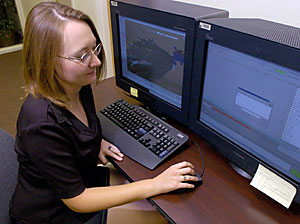 |
|
CHRIS CODUTO/Arizona Daily Wildcat
|
Nicole Spanovich, an astronomy senior checks data files from the Mars Rover yesterday afternoon. Spanovich, spent eight months at the NASA Jet Propulsion Labratory in Pasadena, Calif., working with the rover's multiple cameras.
|
|
|
By Kylee Dawson
Arizona Daily Wildcat
Thursday, September 30, 2004
Print this
UA astronomy senior Nicole Spanovich telecommutes to work every day, to either Pasadena, Calif., or Mars.
When she's not in class, Spanovich can be found behind a computer in the UA Lunar and Planetary Laboratory's Phoenix Project building either sending commands to a pair of rovers on Mars, or Web conferencing with NASA scientists in Pasadena.
After working at the NASA Jet Propulsion Laboratory in Pasadena for six months, Spanovich has been running a remote operations center for NASA's Mars Exploration Rover mission in Tucson since August.
The MER mission began when two rovers - Spirit, which monitors the Gusev crater and Opportunity, which monitors the Meridioni Terra - were launched into space in summer 2003 and both landed on Mars in January.
The rovers, "were equipped with instruments that were able to identify minerals that formed through the action of water," UA lunar and planetary scientist Peter H. Smith said.
"The rovers were guided to equatorial locations that showed the presence of water. By studying the interior of rocks, drilled by an abrasion tool on a robotic arm, scientists were able to study the ancient history of these two locations," Smith said.
The mission was set to operate only until April, but it was expanded through September, when NASA gave scientists an extra $15 million.
Spanovich found out about the Mars rover mission in May 2003 when Smith gave a presentation in her planetary sciences class about Mars.
She began working at the JPL in December of that year when she volunteered to work with Smith on the Mars rover mission.
"I wasn't into any research in my field yet," Spanovich said. "I was definitely trying to get involved and when he introduced the subject ... I just jumped on that."
When the MER mission began, Smith was the only person from the UA working on the mission until Spanovich joined his team at JPL to operate the rovers once they landed.
Spanovich returned to Tucson for the fall semester, but was able to set up a computer at the UA that allows her to monitor and operate the rovers just as she did at the JPL.
"I was interested in astronomy since I was little," Spanovich said.
"The stars and space and just the unknown about it really fascinated me so it was just a natural field for me to enter into."
"This is the first operational use of our new university building since we moved in last May," Smith said. "Scientists are thrilled at the data that we are returning to the UA and the opportunities that we are giving students who are interested in the exploration of the solar system."
